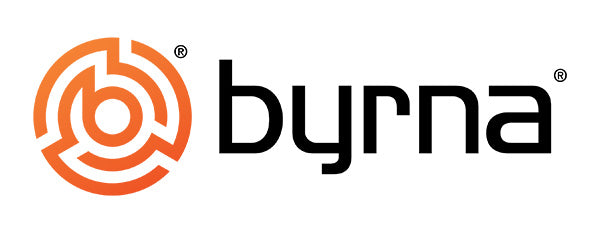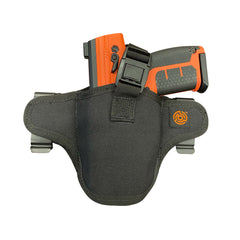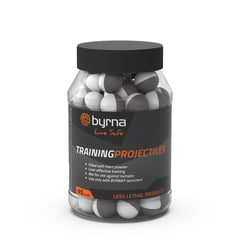
A laser sight can help improve your accuracy by as much as 30% when you're using a less-lethal launcher, and it can increase the opportunities that someone will surrender before you even have to fire. If you hear glass breaking at 2 AM and you grab our Byrna SD or less-lethal launcher, that little green dot could be the difference between hitting your target center mass and missing in a way that puts everyone in danger. Most people don't know how much stress changes their aim.
Less-lethal launchers like our Byrna LE shoot irritant rounds instead of bullets, which means they can stop threats without causing permanent damage. Police studies have shown that suspects are more likely to surrender when they see that laser dot on their chest. When you combine the better accuracy with how it makes people think twice about resisting, these devices end up being a lot more helpful than just relying on iron sights.
I'll go through the real performance data with you and show you the pros and cons so you can figure out if a laser sight makes sense for your particular launcher.
Table of Contents
How Laser Sights Improve Your Accuracy
When you mount a laser sight on your less-lethal launcher, you'll see some real improvements in where your shots land. I've seen recent training studies that show shooters with laser-equipped launchers get better shot groups by around 30% at the usual distances they work at. That's a big improvement and shows you how much it matters to place your shots well when situations get tense.
These accuracy improvements get even better under stress. People who use green laser sights usually stay 15-25% more accurate than with iron sights alone. This holds true when everything's moving fast. Stress does change everything about shooting. Your hands usually shake less when you have that green dot to show you where to aim instead of trying to line up standard sights when you're under pressure.
Less-lethal launchers come with their own set of problems that make lasers especially helpful. These weapons usually have shorter barrels and shoot projectiles slower than normal guns. The physics here work against you. The laser balances out these problems with a precise point to aim at. You can track your target better and quickly adjust your aim before you shoot.

Timing matters quite a bit here. People with laser sights usually get their first hit faster because finding your target is almost instant. In tense situations, your speed can make a difference. You don't have to line up front and rear sights or worry about making sure your sight picture is right when everything gets crazy.
But you shouldn't let the laser replace the shooting technique completely. The laser acts as a coach that tells you where your shot will go. You still need to control your breathing and trigger pull to actually use that accuracy improvement.
How Laser Dots Create Mental Pressure
You might wonder how a small red or green dot can change how someone thinks in a tense situation - it all comes down to how our brains process threats. When someone sees that laser dot show up on their chest, their fight-or-flight response starts working immediately.
The dot creates what experts call "threat cue recognition" in the brain.
Your target realizes they're in someone's crosshairs. That realization hits them fast - this uncertainty makes their stress response worse and forces them to make a quick choice about what happens next.

Police reports show that when people can see laser targeting, it usually results in faster surrender rates during standoffs. The laser shows your readiness and intentions without you having to say a single word. When you use visible targeting, it changes the whole feel of a confrontation. Suspects who might otherwise get violent or try to run away usually give up when they see that precise red dot following their movement. The mental pressure builds up as they understand someone has an accurate aim on them - it gets pretty obvious that you're in a better position, all without making verbal threats or making physical contact.
With that said, you need to be careful about when and how you use this tool. Laws around "menacing" still apply even with less-lethal weapons. You can't just point that laser at someone to scare them without a valid reason.
The real question is if this mental edge will last forever. As laser sights become more common on all kinds of weapons, people might start to shrug them off. What seems effective now might not work as well tomorrow when everyone expects to see that little dot. As more people get used to seeing laser sights everywhere, it could change how they respond to laser targeting over the next decade or so. When people always see laser sights in media and real life, they might not be as shocked by them. The edge you're counting on now might need some backup plans as people get more familiar with them.
How Green and Red Lasers Compare for Visibility
The science behind laser colors matters more than most people think when you're trying to aim under pressure. Green lasers work at wavelengths between 495-570 nanometers, while red lasers work at 620-750 nanometers. Your eyes naturally evolved to see green foliage - that same tendency makes green lasers pop against almost any background. Most shooters skip over this part and then wonder why their setup doesn't feel quite right.
Recent tests show that green lasers help you find your targets about half a second faster than red ones in low light and about two-thirds of a second faster when you're in daylight conditions. When you need to make a split-second choice with a less-lethal launcher, those little fractions of a second can make all of the difference. That extra speed gives you more confidence when every second matters. Your muscle memory builds up faster when you have steady visual feedback to work with. Your training sessions become more productive when you can track where you're aiming without having to squint or adjust your stance.
Green lasers look brighter to us because human vision is naturally more sensitive to that particular wavelength. So you'll have better visibility inside or outside. You'll be able to see your dot even when there's ambient light around that would completely wash out a red laser.

Red lasers do have one big plus, though. They use much less power than green lasers, which means your batteries will last much longer. If you're going to be in situations where you can't swap out batteries fast, that's a real issue for keeping your equipment reliable. When your batteries die, you lose your aiming help right when you might need it most. Your backup plan should always take into account what happens if your power fails.
Laser colors come with eye safety classifications that you need to know about. Class IIIa lasers are usually safe for quick exposure. Class IIIb units mean you need to be more careful about how you use them. You should never point any laser directly into someone's eyes - even when you're just training. The temporary vision problems you could cause just aren't worth the danger to bystanders or your training partners.
The cost differences between red and green can be pretty big. Green laser technology usually costs more when you first buy it. But the performance benefits make it worth the extra expense.
How to Set Up Your Laser System
Most people skip the setup process and then ask themselves why their laser never hits where they point it. The fact is that if you don't zero your laser, you won't have accuracy with any less-lethal launcher.
First, pick out your distance. For indoor defense situations, you'll work best with a 15 to 20-foot zero. If you're going to patrol outdoors or need to shoot at longer ranges, you might want to go with a 30-foot zero instead. Just remember that less-lethal projectiles drop much faster than bullets do, so your laser is going to sit high at close range and low when you're shooting far away. The distance you pick is going to matter with every shot you take from that point on. When you zero your launcher at the range where you'll actually be working with it, everything gets more predictable. If you skip this, then you'll be trying to compensate for trajectory differences every single time you use your weapon.
Before you fire your first shot, you should find a steady rest for your launcher. Most people try to zero while they're holding the launcher in their hands, and they keep making adjustment after adjustment without going anywhere. What you need is to keep your shooting position the same between shots. Go ahead and fire a three-shot group, then check where it lands compared to where your laser dot was pointing. Adjust your windage first, and then work on your elevation.

The newer LaserLyte MBS-1 stays visible out to about 65 yards when you're pointing it at decent surfaces. Some of the higher-end models, like the RIP-3C, can reach out to 550 yards, and they come with visible and infrared options. These ranges matter because you need to be able to see your dot well at whatever distance you picked for your zero. Being able to see your laser is what determines if it's going to work when you need it. Different surfaces are going to bounce laser light back differently depending on the lighting conditions you're in. Your dot might just disappear on some targets or backgrounds. Test your particular model at the distance where you zeroed it before you start depending on it.
It's worth taking a quick look at your mounting system before you get started. Most launchers are going to use standard Picatinny rails. Some manufacturers use different systems, though. The RIP-3C uses mil-standard M1913 rails and tends to sit lower than most of the competition - this helps lower the offset between where your laser sits and your bore axis.
When you mount your laser, tighten it down to the right specs. CO2 recoil might not seem like much. But over time, it's going to loosen a laser that isn't mounted tightly enough. Most users can get their laser zeroed within three or four shots as long as their mount stays tight throughout the process.
Laws and Ethics You Should Know
Before you mount that laser sight, take a step back and look at your department's policies.
Most agencies need officers to go through laser qualification courses before they can use these devices out in the field. It's worth checking this out first. These standards are there for real reasons, and they give you a helpful framework to work with.
For the legal side, it gets messy pretty fast. Federal law takes laser devices really seriously. That's also the case when we're talking about aircraft interference. You could face big charges if you point a laser at the wrong target. Some states have their own laws on brandishing or assault with laser devices, too.

You'll need to change up your training as well. Your usual shoot and no-shoot drills need to include that laser sight once it's mounted on your launcher. The bright red dot can create tunnel vision where you're only looking at where the laser points - this actually happens more than people think, and it can make you miss important facts going on around your target.
Use-of-force instructors will tell you about this same problem all of the time. They see officers who become too dependent on their laser sights and lose track of what's going on around them. What happens is that the technology starts replacing sound judgment instead of improving it. Officers develop false confidence in their equipment instead of trusting their skills. You can actually see this dependency in qualification tests when the laser stops working. Your muscle memory needs to work without any electronic help.
Here's the real question you need to ask yourself - does a laser sight make you more confident when situations get intense? Or does it make you complacent because you figure the technology will take care of the tough calls for you? The laser can help with accuracy. But it can't replace your training or your ability to read what's going on. Equipment always seems to fail right when you need it most.
Protect Yourself and Your Family
When you add a laser sight to your less-lethal launcher, you get some real benefits that you can't ignore. The improved accuracy lets you put shots right where they need to go. The bright red or green dot can actually stop a situation from going south before you even have to pull the trigger. That's stopping power without firing a single shot. When you're in low-light situations, you'll have a real edge, and these benefits become more obvious as the technology improves.
Now, of course, this comes with responsibilities that you'll need to think through pretty closely. Your accuracy is going to depend on how lasers behave at different ranges. Every distance will change where that dot actually lands on your target. If you miss when you need to hit your mark, that's the real danger you're taking. You'll need more training because you have to know how your laser works at these different distances, and you need to stay aware of the legal and ethical duties that come with any self-defense tool. These challenges are real. But with the right preparation and standard practice, they become more manageable.
As the laser technology improves and the prices drop, we might start to see these little red dots become just as common as safety switches on less-lethal devices. You can already see the trend taking hold in law enforcement and civilian markets, and compatibility options are showing up all of the time. You should test out different setups, train with whatever system you're using, and figure out for yourself if that focused beam of light deserves a permanent place on your launcher.

When we're talking about reliable, less-lethal options - that's where we're great. Our less-lethal tools work in all 50 states, and you don't need any background checks; plus, our patented pull-pierce CO2 system gets you up and running instantly when every second counts. You won't have any waiting periods to slow you down. If you're in the market for pistols, rifles, or full safety packages, visit us at Byrna.com to connect with the same gear that tens of thousands of reviewers already trust for their protection.




